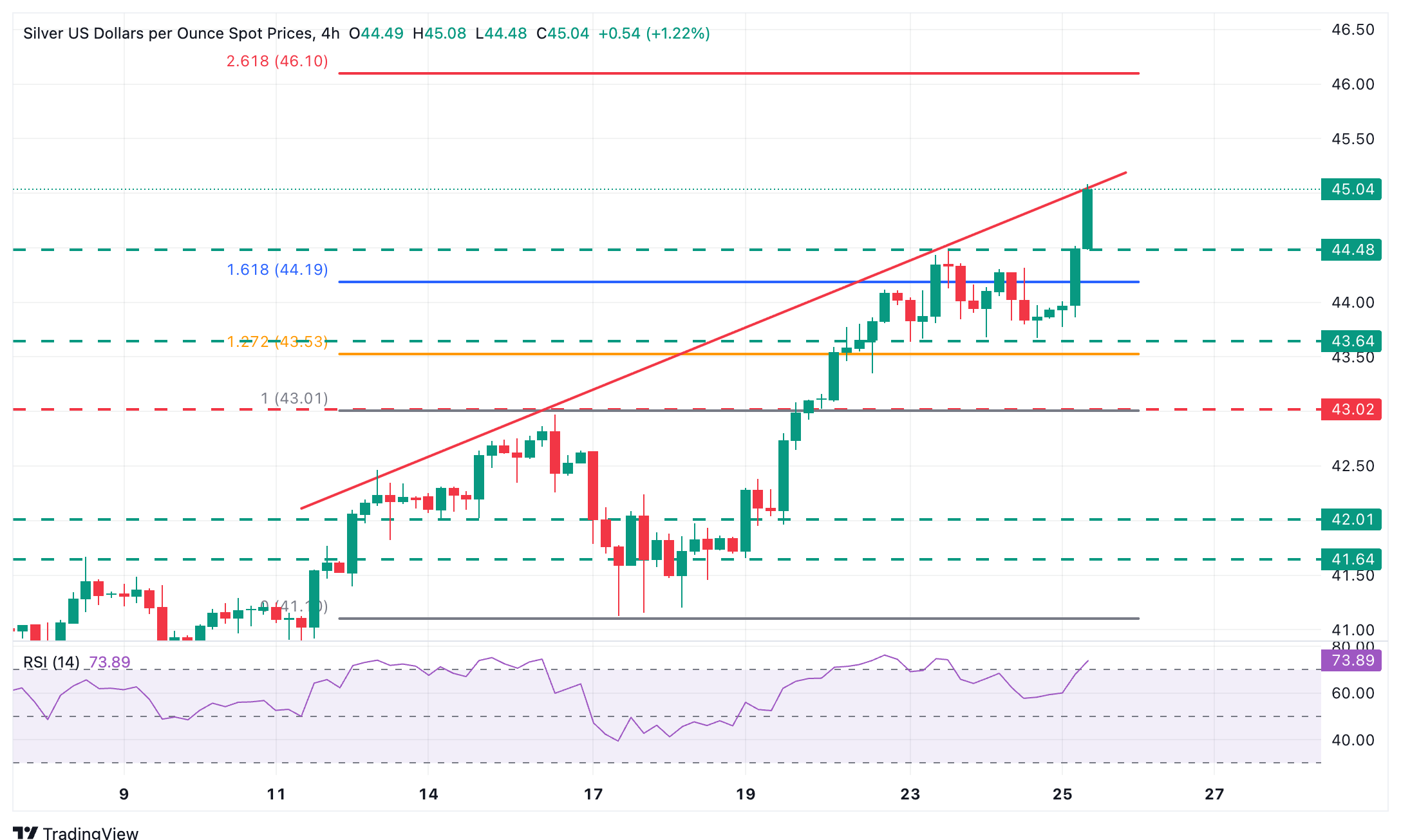Silver Price Forecast: XAG/USD hits fresh highs at $45,00 ahead of US GDP
- Silver bounced and resumed its uptrend on Thursday to hit fresh long-term highs at $45.00.
- Safe-haven demand amid ongoing geopolitical concerns is supporting precious metals.
- XAG/USD is at overbought levels after rallying nearly 17% over the last three weeks.
Silver’s (XAG/USD) has resumed its bullish trend on Thursday, reaching fresh multi-year highs at $44,90 so far. The precious metal has drawn some support from a stalled US Dollar’s recovery, with investors cautious ahead of the final reading of the Q2 US GDP and a slew of speeches from Fed policymakers due later in the day.
Precious metals are trading higher as ongoing geopolitical tensions in Europe and the Middle East keep weighing on risk appetite. Denmark has been forced to close some of its main airports today amid reported “coordinated drone attacks,” with Russia emerging as the main suspect.
Technical Analysis: Silver is back to overbought levels

With today’s rally, the XAG/USD pair reaches levels nearly 17% above late August lows, and such steep rallies tend to come to an end. The Relative Strength Index has reached oversold levels at most time frames, which hints at a potential correction.
On the upside, a trendline resistance right above $45,00 level might challenge bulls. Above here, the 261% Fibonacci retracement of the 16-17 September pullback, at $46.10, emerges as the next potential target.
To the downside, immediate support is at the previous highs of $44.50 (September 23 high), ahead of the September 23 and 24 lows, at $43.65, and the September 16 high, at the $43.00 area.
Silver FAQs
Silver is a precious metal highly traded among investors. It has been historically used as a store of value and a medium of exchange. Although less popular than Gold, traders may turn to Silver to diversify their investment portfolio, for its intrinsic value or as a potential hedge during high-inflation periods. Investors can buy physical Silver, in coins or in bars, or trade it through vehicles such as Exchange Traded Funds, which track its price on international markets.
Silver prices can move due to a wide range of factors. Geopolitical instability or fears of a deep recession can make Silver price escalate due to its safe-haven status, although to a lesser extent than Gold's. As a yieldless asset, Silver tends to rise with lower interest rates. Its moves also depend on how the US Dollar (USD) behaves as the asset is priced in dollars (XAG/USD). A strong Dollar tends to keep the price of Silver at bay, whereas a weaker Dollar is likely to propel prices up. Other factors such as investment demand, mining supply – Silver is much more abundant than Gold – and recycling rates can also affect prices.
Silver is widely used in industry, particularly in sectors such as electronics or solar energy, as it has one of the highest electric conductivity of all metals – more than Copper and Gold. A surge in demand can increase prices, while a decline tends to lower them. Dynamics in the US, Chinese and Indian economies can also contribute to price swings: for the US and particularly China, their big industrial sectors use Silver in various processes; in India, consumers’ demand for the precious metal for jewellery also plays a key role in setting prices.
Silver prices tend to follow Gold's moves. When Gold prices rise, Silver typically follows suit, as their status as safe-haven assets is similar. The Gold/Silver ratio, which shows the number of ounces of Silver needed to equal the value of one ounce of Gold, may help to determine the relative valuation between both metals. Some investors may consider a high ratio as an indicator that Silver is undervalued, or Gold is overvalued. On the contrary, a low ratio might suggest that Gold is undervalued relative to Silver.

